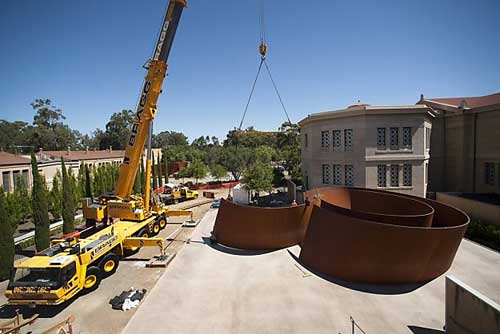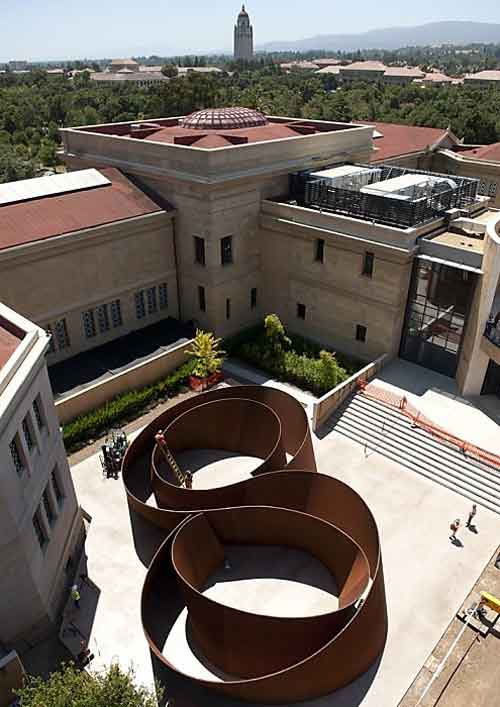
 Sculpture News at SculptSite.com
Sculpture News at SculptSite.com
Richard Serra Sculpture |
| San Francisco Chronicle by Kenneth Baker - Chronicle Art Critic The art of installing Richard Serra's sculptureIn a few years, when the San Francisco Museum of Modern Art opens the mammoth extension designed for it by the Norwegian architect team SnØhetta, Richard Serra's extraordinary sculpture "Sequence" (2006) will anchor it. Meanwhile "Sequence," one of the crowning components of SFMOMA's Doris and Donald Fisher Collection, sits behind the Cantor Arts Center at Stanford. Other commitments kept Serra away from Stanford during the mid-July transplant of "Sequence" from the Los Angeles County Museum of Art, where it had filled half the ground floor of LACMA' s Broad Contemporary Art Museum since it opened in 2008. "It's fairly symmetrical and simpleminded designwise," Serra said of "Sequence" in a phone conversation. "You could probably find it somewhere in ancient Yemen or maybe in American Indian art. ... It's the connection between the two spirals that causes you to turn back on yourself, and you really do lose yourself in it." Was he surprised by experiencing the work's complexities? "I wouldn't make them if I weren't surprised," he said. "I have my own tool box, and I know what happens when something leans one way or another, but in terms of the intervals, and what happens when you're turned about, I can't foresee that. "The piece is in a holding pattern right now," Serra said of "Sequence." "The problematic thing ... is that it's a temporary installation. But in San Francisco we're going to great lengths to figure access, stairways, views from above, views from the street. We discussed all that when I met with the architects about 10 months ago." Serra has not yet seen "Sequence" outdoors, though he did walk it under the high skylights of the foundry in Germany that fabricated it. In the open-air site behind the Cantor, sunlight and shadows complicate the play of contours and orientation that reach a dizzying intensity within the piece, even indoors. Serra will get a fresh look at the work when he comes west to install "Richard Serra Drawing: A Retrospective," which opens at SFMOMA in mid-October. I arrived at Stanford as a rigging crew was completing the installation of "Sequence" on a recently poured concrete slab behind the museum. A giant crane, hired by the riggers, stretched several stories above the buildings' roofline. Placement and assembly of the 235-ton piece had gone smoothly, taking only about three days. But "LACMA was a difficult removal," said Joe Vilardi of Budco, the rigging specialists that Serra has used for many years. "There wasn't a lot of ceiling height, the crane was huge and was far back. We were there for about a week and a half, and that didn't account for the setup or the removal of the crane. The crane took a week to assemble." On the other hand, trucking, done by yet another contractor, "was simple. They had them up here in an eight-hour shift or something like that." Vilardi's company, a family business for which he began working at 15, does all kinds of projects. When a construction crane collapsed on Manhattan's East Side in 2008, killing several people and damaging a whole block of buildings, overwhelmed public safety officials hired Vilardi to sort out the mess. But in the normal course of business, "we do all of Richard's installations," Vilardi said. "He's our biggest client. He gets our full attention, for sure." Does that mean that Serra consults Vilardi on questions such as how many plates compose a sculpture? "That is one of the things we try to discuss with Richard sometimes," Vilardi said, "but what it really boils down to is that these plates are designed for stability, so each one can be freestanding, and that really dictates where the joints are going to be, then where Richard wants them to be - how visible - and lastly the issue of moving them around." Serra recalled the disheartened expression on the riggers' faces when, after they had installed a New York gallery show for him, he asked them to move two pieces 5 feet. Transportation "is always an issue," Vilardi said. "We've had some conversations about what are the limits, in regards to trucking. The sculpture coming into New York now" for Serra's fall gallery show "is substantially bigger than this," meaning "Sequence." "Indoors we use a hydraulic gantry" to move the plates, Vilardi said. "You need a certain amount of room overhead to use these things and we're always pushing the envelope with what that allowable space is going to be." |
 Richard Serra's sculpture "Sequence" really takes hold of your mind and senses. Such an imaginative sculpture creation. Very nice and informative article by Kenneth Baker. Yes, good riggers are paramount to installations of these large sculptures. Oh, one more thing - you may want to keep mid-October in mind for the Richard Serra Drawing: A Retrospective," at SFMOMA. |
 |
| Riggers use a giant crane to assemble Richard Serra's 2006 weathering steel sculpture "Sequence" behind Stanford University's Cantor Arts Center. Photo: linda cicero / stanford university news dept. |
 |
| An aerial view of the 235-ton artwork, which eventually will anchor the SFMOMA home of the Fisher collection. Photo: linda cicero / stanford university news dept. |
More Sculpture News ....
Submit your SCULPTURE NEWS.
It's easy, just send us an e-mail
(click on Submit News in the left menu) with your pertinent information along with images, we'll take care of the rest. Sculpture makes our world a much better place in so many ways!
SculptSite.com, along with Sculptors and their creative genius all helping to bring the beauty and message of Sculpture to a hurried world.

